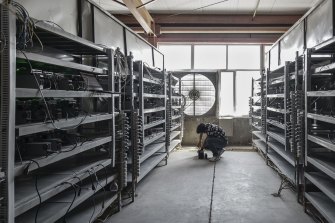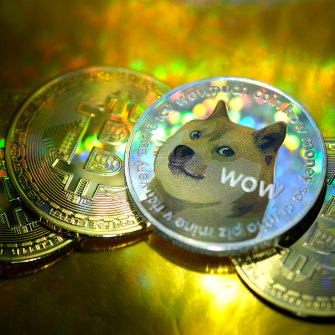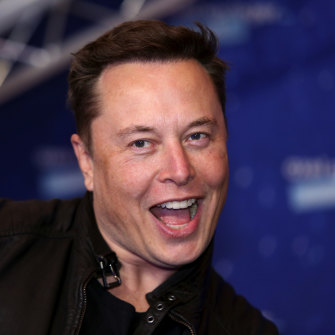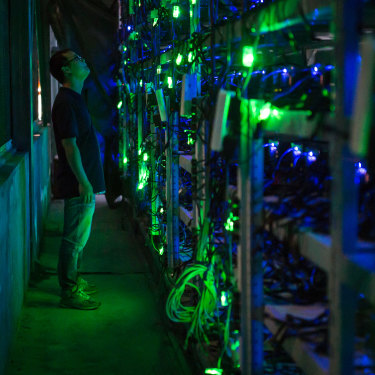$60,000 and rising: How does bitcoin work and why is Elon Musk buying it?
What did two pizzas have to do with the beginnings of Bitcoin? Why is there so much fuss about it now? And why should you probably not buy it if you’re prone to forgetting passwords?
In May 2010, on a sunny day in Florida, programmer Laszlo Hanyecz bought two pizzas.
Purchased for a friend in California, the two Papa John’s-branded treats set him back around $US30. Today, if he was to make the same transaction, the meal would cost him $600 million.
That’s because Hanyecz paid for the dinner online in bitcoin – 10,000 of them, to be exact – a move widely regarded as the first major commercial transaction involving the mysterious currency and one that helped catapult it into the mainstream.
Back then, the only places you might have heard of bitcoin or other cryptocurrencies would have been in the dark depths of an internet message board, uttered by nerdy teens looking for discrete ways to purchase drugs (or pizza).
Today, the digital currency has stormed the world, with its rapidly increasing price, unique technology and devout fan base catching the eye of investors everywhere – including the world’s richest man, Elon Musk.
Often likened to “digital gold”, the asset has exploded in price over the past 12 months, recently topping $60,000 per coin – a far cry from Hanyecz’s purchase price of 0.3¢ in 2010.
But what exactly is bitcoin, and how is it made? Why is everyone talking about it right now? And how does someone buy one?
What is bitcoin, and how is it made?
In 2008 – two years before the famous pizza delivery – an anonymous person or group of people known only as Satoshi Nakamoto released an explanatory paper titled Bitcoin: A Peer-to-Peer Electronic Cash System. Laid out in the document was Nakamoto’s idea for an electronic version of cash that would be secure, stable, trusted and trackable, all without the need for a central financial institution.
In essence, Nakamoto’s original vision for bitcoin still holds true today. It is what’s known as a cryptocurrency: a digital currency that is secured and encoded through computer algorithms (cryptography), making it incredibly difficult to counterfeit. Cryptocurrencies are different from traditional virtual currencies, such as a digital version of the Australian dollar, as they are not issued by central banks or institutions.
You won’t find the local Bitcoin headquarters in a city CBD, nor will you hear about the exploits of bitcoin’s CEO.
You won’t find the local bitcoin headquarters in a city CBD, nor will you hear about the exploits of bitcoin’s CEO. You won’t be able to put any shiny gold bitcoins in your back pocket, nor call up the bitcoin hotline when you’ve got an issue with your bitcoin credit card.
None of these things exist. Bitcoins are not physical objects, and the operation of the cryptocurrency is entirely decentralised. There’s no central server or system that runs the bitcoin network.
Instead, the network exists on a web of millions of computers across the globe, each linked to one another and tasked with verifying, cross-referencing and processing transactions on the network.
Let’s say you send your mum five bitcoins as an incredibly generous birthday present. On pressing send, these computers, called nodes, would each independently check that your transaction was above board. If a majority agreed, your transaction would be chronologically added to a long public list – or chain – of every bitcoin transaction in existence.
Every 10 minutes, the computers managing the network package all transactions received during that time as a “block”, which is cryptographically linked to the preceding block. These blocks are unable to be modified or changed and can be traced all the way back to January 2009 when the network was first switched on.

This forms the “blockchain”, the underlying technology on which almost all cryptocurrencies are based, as bitcoin is far from the only cryptocurrency to operate on this model. There are hundreds of other “cryptos” similar to bitcoin, including Ethereum, a platform that allows users to execute automatic contracts (theoretically, you could negotiate the sale of a house on Ethereum but not on bitcoin) and Ripple, a fast payment service popular among banks and other financial institutions. There are even cryptos made entirely as jokes (albeit that have value) such as dogecoin, based on an internet meme about a sheepish-looking Japanese dog.

The reasons for running the network in this fashion are numerous. For example, if one computer processing transaction crashes, millions of others can step in and pick up the slack. Similarly, if someone was to try to dupe the system with a fraudulent transaction, every other node could reference it with its own copy of the blockchain, see it was invalid and refuse to verify it.
But, as with all things, money is the true incentive. The process of verifying and recording the estimated 400,000 bitcoin transactions that occur every day requires incredible computing power, and individuals can hardly be expected to keep them running on pure altruism.
Here’s where the money comes in. Every 10 minutes, the first computer (or group of computers) to announce to the rest of the network that it has successfully verified all the transactions in a block is rewarded with 6.25 bitcoin, or around $375,000, which is then sold into the wider market – with the miner making a tidy profit.
This whole process is known as “mining” and is the crux of how the self-generating bitcoin sausage is made. Mining was once a relatively simple process and could be done on any old laptop. However, bitcoin’s programming is designed to make the coins harder and harder to obtain, so the computational difficulty of verifying transactions has gotten increasingly hard as the years go on.
These days, bitcoin mining is a business in itself. Massive companies operate out of places such as China, Russia and Amsterdam, tasked with overseeing warehouses full of computers dedicated entirely to mining bitcoin. One miner, based in the Chinese city of Dalian, mines approximately 750 bitcoins ($44.6 million) a month.
As the price of bitcoin has rapidly gone up, so has the revenue of miners, who pocket an estimated collective $US45 million a day in block rewards and transaction fees.
As you can imagine, doing this is a power-hungry process. The Bitcoin Power Index, run by Digiconimist, estimates the bitcoin network has an annual carbon footprint comparable to New Zealand’s. The electricity consumed in making one bitcoin transaction could power an average US household for over 23 days.
As many of the largest miners are based in China, the electricity used isn’t particularly clean either, with the country producing about 70 per cent of its power from burning coal. This is why many sustainability advocates prefer other cryptocurrencies, such as Ethereum, which have far cheaper running costs and don’t use as much energy.
What’s all the fuss about? Why is it worth so much?
For a finance traditionalist, bitcoin’s value can be a tricky thing to understand. Why should something with no product or commodity tied to its value, and that generates no cash flow of its own, be worth $60,000 apiece? Isn’t it all ones and zeroes floating around on the internet?
Well, yes. These are all valid points and ones often raised by the cryptocurrency’s detractors, who have frequently denounced the asset as a scam comparable to a Ponzi scheme, believing the coins maintain value only as long as there’s a steady stream of greater fools willing to buy in.
However, bitcoin’s sky-high price becomes easier to wrap one’s head around when compared to one of civilisation’s most ancient signs of wealth and value: gold.
As with gold, bitcoin is scarce. It is programmed in such a way that there can only ever be 21 million coins in existence, which means it will become harder and harder to mine as time goes on. There are about 18.6 million coins in circulation at the moment.
This scarcity has become increasingly attractive for investors over the past 12 months as central banks around the world pumped stimulus into the economy and printed money at a rapid clip in response to COVID-19, sending interest rates to record lows.
Holding money in cash is generating measly returns, meaning investors are looking further afield for assets that may appreciate faster. Major international funds such as BlackRock have begun to invest in the asset, alongside Wall Street legends such as Stanley Druckenmiller and Paul Tudor Jones.
Vladimir Kipic, director of Sydney-based construction firm Vbuilt, recently decided to invest some of his company’s assets in cryptocurrencies, viewing them as a better alternative to holding money in cash.
“Of the $100,000 we put in, we’re up about $40,000. That’s pretty good in my eyes.”
“With my business, we’ve usually got a bit of money laying around, so I thought this would be a good way to invest it so it’s an asset for the company,” he says. “Of the $100,000 we put in, we’re up about $40,000. That’s pretty good in my eyes.” Kipic is also considering accepting customer payments in cryptocurrency.
Most recently, the world’s richest man, Elon Musk, announced that his automotive company, Tesla, had invested $US1.5 billion in bitcoin and would begin to accept the cryptocurrency as a payment option for its electric cars. Following the news, the price of bitcoin spiked nearly 20 per cent to a new record high as many flocked to emulate Musk’s surprise purchase.

”If any lesser mortals had made the decision to put part of their balance sheet in bitcoin, I don’t think it would have been taken seriously,” Thomas Hayes, managing member at New York fund Great Hill Capital, told Reuters.
“But when the richest man in the world does it, everyone has to take a second look.”
Musk has long been an advocate for cryptocurrency and many prospective Tesla owners are often young and male, intersecting well with the core demographic of bitcoin investors. The company also signalled it could look to invest further in cryptocurrencies, noting it may “acquire and hold digital assets from time to time or long-term”.

Finally, bitcoin’s price is in part driven by its devout, almost religious, followers, who extol the currency’s freedom from governments and banks and believe it will be a leading global currency in years to come.
Asher Tan was working as an economist on Melbourne’s Collins Street in 2011 when he first caught wind of bitcoin. He recalls reading distinguished US economist Paul Krugman’s haranguing of the then-obscure currency.
“At its core, it’s a message of old versus new, bottom-up versus top-down …”
“I read his stuff on it enough times and thought, maybe he’s my idol, but maybe he’s wrong,” Tan says. “It was quite polarising.“
Tan now runs one of Australia’s most prominent crypto exchanges, CoinJar, but back then, he says the idea of a social movement driven by the internet and the democratisation of finance was quite novel.
“At its core, it’s a message of old versus new, bottom-up versus top-down, and bitcoin is the medium through which a lot of people choose to express this,” he says.
“Bitcoin means different things to different people, but the most important thing is that it’s still here now. Whatever your take, it’s still meaningful and relevant.”

So how do you buy bitcoin?
Back in Hanyecz’s day, buying some bitcoin would have required deep proficiency in the dark arts of the internet, as exchanges were unregulated and often difficult to access.
Today, exchanges are still largely unregulated – but have become far easier to access, requiring only a brief sign-up process and a quick identity check. Apps such as Coinbase are also popular for buying small amounts of bitcoin or other cryptocurrencies.
But be warned: buying crypto is not for the faint of heart. If you’re someone who forgets passwords easily, it might be best to stick to more traditional investment choices, as the potential for screwing up a bitcoin transaction is quite high.
After buying bitcoin or another cryptocurrency from an exchange, the coins are stored in a “wallet” on the platform. These wallets can store any number of currencies and are a key part of trading crypto, much like a trading account with a broker. Only you can access your wallet.
If your purchases start to stretch into the tens of thousands, it might be time to buy your own personal crypto wallet.
For small amounts of money, keeping your money locked up on an exchange is generally pretty safe. But if your purchases start to stretch into the tens of thousands, it might be time to buy your own personal crypto wallet.
These devices look closer to a USB stick than your parent’s leather bifold and connect via software on your computer, which allows you to transfer your coins across.
When setting up a personal wallet for the first time, you are presented with two crucial pieces of information. Firstly, each wallet has a “public key”, which is a string of numbers and letters that allows you to receive coins into your wallet, much like a BSB number and bank account. If your mum wanted to send you back the excessively generous birthday gift you gave her, she’d need this number.
Secondly – and far more importantly – each wallet includes a private key, which is a secret number that grants full access to your stored coins. These often come in the form of a 12- or 24-word recovery phrase, comprising a string of random words.
This phrase is the master key to your bitcoin and should be protected with your life. If you lose your wallet, your private key will allow you to access your coins, but if you lose your private key and lose your wallet, your coins will be lost forever.
It’s worth noting your bitcoins are not actually stored in your wallet. The keys mentioned above give you only the right to access your bitcoin, which is stored on the blockchain. Wallets just serve to store and protect your private key.
What’s next for bitcoin?
It depends on who you ask. Supporters will tell you bitcoin’s use will only increase with time, and that more and more major governments and corporations will start to look at ways to adopt the currency. Detractors will tell you the opposite, reiterating their point that the asset’s value is not grounded in reality.
At the moment, it appears cryptocurrencies, in general, are in a bit of a purple patch, boosted by unprecedented public attention and a wash of stimulus money across the world’s economies. Much like the recent GameStop saga, millennial investors are getting savvier and increasingly interested in high-risk, high-growth assets such as cryptocurrencies.
However, one thing to always expect with bitcoin is a wild ride. By their very nature cryptocurrencies are immensely volatile. They are 24-hour markets, which makes them impossible for traders (who need sleep) to monitor constantly; their lack of regulation means there is greater potential for market manipulation; and they are highly speculative. In the time it took to proofread this article, bitcoin’s price fluctuated by $1000.
So don’t be surprised if that $60,000 bitcoin you just bought is worth $30,000 the next day. Just be thankful it’s not two warm pizzas.
Dominic Powell writes about the retail industry for the Sydney Morning Herald and The Age.
Most Viewed in Business
Source: Thanks smh.com